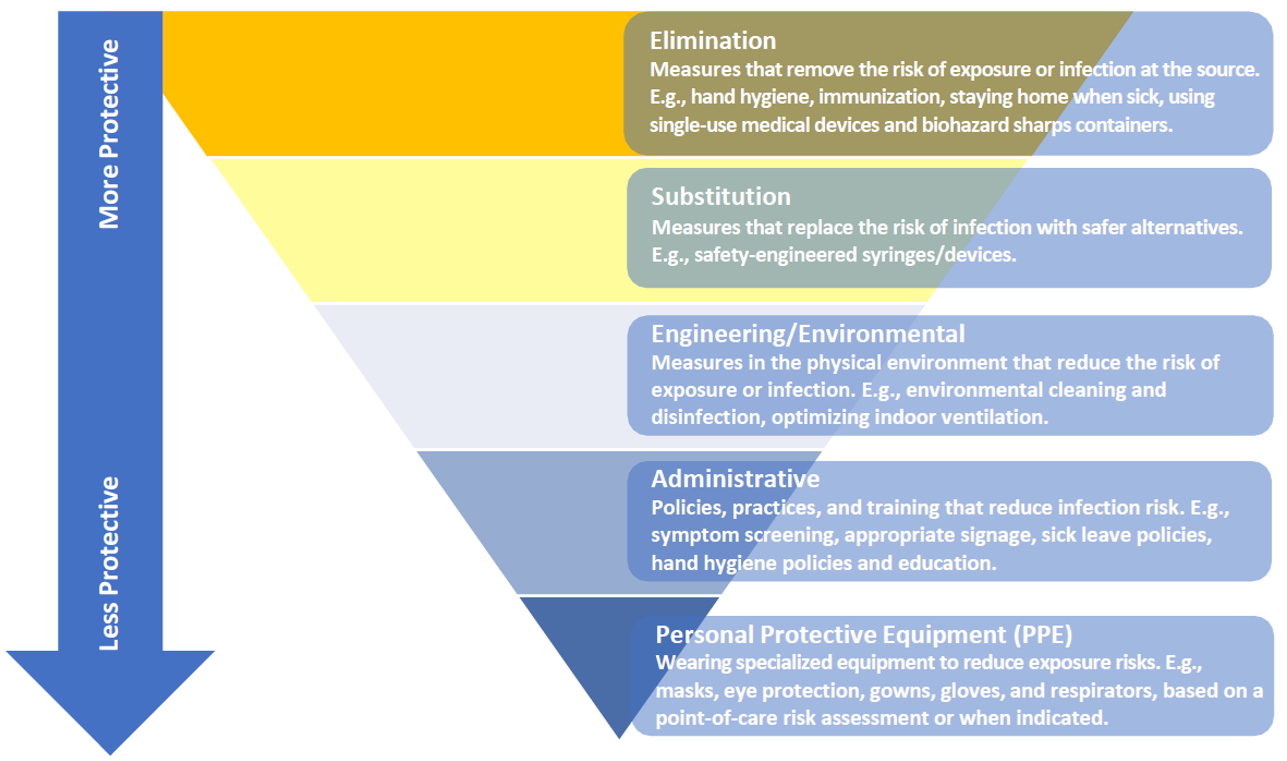Hierarchy for Infection Prevention and Exposure Control Measures
Protecting yourself and others by reducing the transmission of communicable diseases in health care settings is a critical component of health care. There are a wide variety of measures that can be taken. These measures vary in their effectiveness and ability to protect, and they can be ranked and organized into a hierarchy on these bases. Those at the top of the hierarchy are more effective and protective than those at the bottom. By implementing a combination of measures at each level, the risk of transmission is substantially reduced.1

Check out examples of measures at each control level by clicking the titles below:
Elimination Measures
Elimination measures remove the exposure or infection risk at the source. Examples include sharps disposal at point-of-care to reduce sharps injuries, hand hygiene to remove contamination and infectious agents from hands, ensuring immunizations are up to date, staying home when sick, and using single-use medical devices to eliminate the risk of transmission of infectious agents between patients by way of medical devices.
Subsitution Measures
Substitution measures replace the infection risk with a safer alternative. Examples include preventing sharps injury by using safety-engineered devices for injections and cannulations.
Engineering/Environmental Measures
Engineering/environmental measures are physical changes in the health care setting that reduce the exposure or infection risk. Examples include optimizing indoor ventilation and air exchanges, using airborne infection isolation rooms, and environmental cleaning and disinfection.
Administrative Measures
Administrative measures are provincial and organizational infection prevention and control policies, procedures, training, and care practices that prevent exposure to and/or transmission of infections to others. Examples include policies and practices supporting hand hygiene, immunization, sick leave, screening for symptoms and risk factors, patient scheduling and flow, health care worker education and training, implementing additional precautions when needed, and posting appropriate signage.
Personal Protective Equipment (PPE)
Personal protective equipment (PPE) measures refer to the use of specialized equipment that is designed to minimize exposure to a variety of health hazards when worn appropriately. Examples include medical masks, eye protection, gowns, gloves, and respirators (e.g., N95 respirators or equivalent). PPE is considered a less protective infection prevention and exposure control measure because although the use of PPE is the most visible in the hierarchy of controls, it is effective only when used in conjunction with all the other control measures. PPE should be worn in accordance with a point-of-care risk assessment, as required for the task. PPE must be worn and disposed of properly.
At the locations of your clinical rotations, several levels of infection prevention and exposure controls will have been put into place to reduce the risk of person-to-person transmission of communicable diseases, including environmental, administrative, and PPE measures.
When possible, controls offering the highest level of protection will be used during your clinical rotations. If it is not possible to use the highest level of protection (e.g., during treatment of patient), lower levels of control will be used (e.g., PPE).
In the event of an outbreak, Medical Health Officers have the authorization to restrict student access to specific wards and locations at their discretion.2